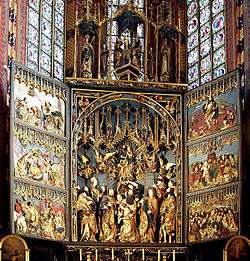Winged altar

.jpg)
The winged altar (also folding altar) or winged retable is a special form of reredos (altarpiece, occasionally retable), common in Central Europe, in which the fixed shrine or corpus can be enclosed by two (triptych), four (pentaptych) or more (polyptych) movable wings. The technical terms are derived from Ancient Greek: τρίς: trís or "triple"; πέντε: pénte or "five"; πολύς: polýs or "many"; and πτυχή: ptychē or "fold, layer".[1] Because the winged altar can display different scenes on weekdays, Sundays or holidays, based on the motifs and type of decoration (painted panels or reliefs), it is also called a liturgical altar. An altarpiece is often mounted on the altar shrine, but more usually it has a carving (carved altar). Above the retable may be found the crowning or superstructure, pinnacles and flowers of the cross. Relics can be housed below it, in a reliquary in the predella lying on the altar stone.
Examples
- Pacher Altar of St. Wolfgang im Salzkammergut
- Kefermarkt Altarpiece in Kefermarkt
- Krakow High Altar in St. Mary's Basilica by Veit Stoß.
- Ghent Altarpiece by Jan van Eyck
- Isenheim Altarpiece by Matthias Grünewald
- Herrenberg Altarpiece, Staatsgalerie Stuttgart
- Antwerp Retable
- The largest collection of medieval reredoses in Germany is to be found in St. Anne’s Abbey, Lübeck, including the Passion Altarpiece by Hans Memling and the Schonen Altarpiece by Bernt Notke
- The Last Judgment by Hans Memling, Danzig
- Schwabach Altarpiece in the Church of St. John and St. Martin in Schwabach, a high altar from the workshop of Michael Wolgemut
Literature
- Herbert Schindler: The Schnitzaltar. Meisterwerke und Meister in Süddeutschland, Österreich und Südtirol. Verlag Friedrich Pustet, Regensburg 1978. ISBN 3-7917-0754-X
- Karl-Werner Bachmann, Géza Jászai, Friedrich Kobler, Catheline Périer-D'Ieteren, Barbara Rommé, Norbert Wolf: Flügelretable, in: Reallexikon zur Deutschen Kunstgeschichte, Vol. 9, 2003, ISBN 3-406-14009-2, cols. 1450–1536.
See also
References
- ↑ Wilhelm Gemoll (1965) (in German), Griechisch-Deutsches Schul- und Handwörterbuch, München/Wien: G. Freytag Verlag/Hölder-Pichler-Tempsky
External links
| Wikimedia Commons has media related to Winged altars. |